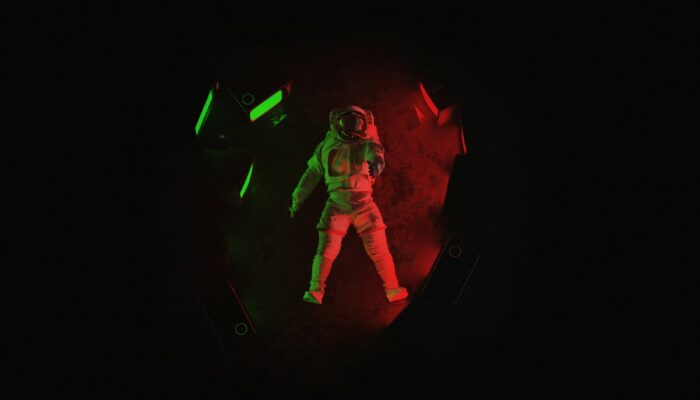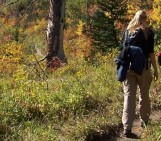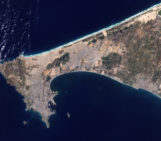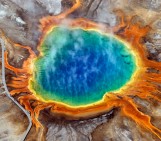
On December 11, 2024, while taking part in AGU’s 2024 Annual Meeting, I attended a press conference hosted by experts from the University of Colorado Boulder and the University of Michigan that focuses on the serious risks posed by space debris in Low Earth Orbit (LEO). As we are heading towards an increasingly crowded space environment, the question on everyone’s mind is: What can we do to prevent the runaway cascade of space debris that could make space exploration and satellite operations untenable?
The issue is serious. Over 1 million pieces of space debris larger than 1 cm are currently orbiting Earth, and 26,000 of these objects are softball-sized or larger and carry the potential to cause catastrophic damage to satellites. These debris fragments not only pose a danger to operational spacecraft, but they also have the potential to trigger the Kessler Syndrome—a cascading series of collisions that could make LEO unusable for decades. With this knowledge in mind, it’s clear that space debris is a problem that transcends borders, industries, and disciplines. It’s a global issue that requires a collective effort from experts, policymakers, and communities alike. So during the Q&A session, I had the opportunity to ask the panellists about their thoughts on the role of community-driven initiatives, such as citizen science and educational programs, in mobilizing public pressure to drive regulatory changes that can mitigate the risks of space debris. While the work of space agencies, academic institutions, and private companies is crucial, the panellists strongly agreed that communities can be strong drivers for policy change.
The tragedy of the commons in space: Why we need collective action
The tragedy of the commons is an apt metaphor for the current state of space debris. Coined by Garrett Hardin in 1968, the tragedy of the commons describes how individual actors, in their relentless pursuit of short-term gain, overexploit and degrade collective goods, a phenomenon now painfully evident in Earth’s orbital junkyard. With over thousands of trackable objects and countless smaller but equally deadly fragments hurtling through LEO at bullet-like speeds, thanks to decades of unbridled satellite launches and rocket stage abandonments, the risks are growing in a worrying speed. The fallout from this orbital chaos is both random and disastrous: a tiny fragment from one company’s dead satellite could destroy another country’s billion-dollar asset, setting off a chain reaction of debris that turns LEO into an impenetrable minefield—without a Hollywood hero to save the day. A real-world example is the 2009 collision between a defunct Russian satellite (Kosmos-2251) and an active U.S. Iridium communications satellite (Iridium 33). This smash-up generated over 2,000 pieces of trackable debris, with countless smaller fragments, which now pose a threat to other satellites and even crewed missions.
Solutions like the Space Sustainability Rating and debris mitigation guidelines from organizations like UNOOSA exist, but remain as toothless as a satellite without propulsion. What’s needed is not more kumbaya-style agreements that countries can nod along to and ignore, but enforceable, binding commitments to debris removal and sustainable satellite deployment—because if we keep treating space like a billionaire’s backyard, we’ll soon have nowhere left to look but down.
Citizen science: On communities monitoring space debris
One of the most effective ways communities can contribute to the fight against space debris is through citizen science. Amateurs and hobbyists have been tracking space debris for years, and their contributions are becoming more critical as space becomes increasingly congested. Amateur astronomers, using telescopes and other tracking tools, are helping to monitor objects that are too small or too distant for professional organisations to track effectively.
For instance, many amateur astronomers have been instrumental in monitoring the Starlink satellite constellation—a rapidly growing network of communication satellites launched by SpaceX. These satellites, which are designed to provide global internet coverage, have sparked concerns among experts due to their potential to add to the growing debris problem. Amateur astronomers, often working independently or in small groups, have been able to track the movement of these satellites and report on their behaviour in the sky.
Educational programs: The way for the public to advocate for change
In addition to citizen science, educational programs are an excellent means to raise awareness about space debris and its risks. By breaking down the complexities of orbital mechanics and debris mitigation into accessible concepts, these programs help not only to demystify the problem but also enables people to understand why orbital sustainability matters and how they can contribute to advocacy efforts. Public education campaigns shed light on the long-term risks of unchecked space debris, from the potential loss of critical satellite services to the looming threat of the Kessler Syndrome. When people understand that preserving space is as vital as safeguarding oceans or forests, they’re more likely to engage in meaningful action.
Workshops that bring together industry leaders, policymakers, academics, and the public—offer a strong model for education and collaboration. These forums provide space to discuss cutting-edge mitigation strategies, such as active debris removal (ADR) technologies and satellite design improvements aimed at reducing long-term orbital clutter. For example, programs like the European Space Agency’s Clean Space initiative have showcased how ADR can be paired with eco-friendly satellite manufacturing to tackle the issue holistically. Cross-sector dialogue is therefore needed, and such workshops provide the opportunity for it. This allows all parties involved to develop a deep understanding of the importance of regulatory frameworks that align technological innovation with international cooperation.
When the problem is deciphered to non-expert audiences, pace debris shifts from being a distant, abstract issue to one that affects our only survivable planet and therefore our own existence. After all, the satellites endangered by debris power the smartphones we hold, the weather forecasts we rely on, and the emergency communications we might one day need. When education humanizes these stakes, it inspires a broad coalition of advocates—students, professionals, and community leaders—to advocate for space sustainability as a shared responsibility.
Bringing stakeholders together: Industry, governments, and academia
Scientists from the University of Colorado Boulder’s Laboratory for Atmospheric and Space Physics, like those who participated in the press conference I attended, are studying the effects of space weather and its role in the accumulation of debris. Their research is essential for understanding how debris behaves in orbit and how it can be mitigated. Meanwhile, space industry leaders can contribute their expertise in satellite design and debris removal technologies, and government representatives can ensure that policies are crafted to incentivise the adoption of these solutions.
These collaborative efforts are already underway, but the inclusion of the public is critical for ensuring that regulations are not only scientifically sound but also socially supported. As the press conference highlighted, the science of space debris is clear, but the regulations required to tackle it are still evolving. Bringing all stakeholders into the conversation—including the community—will be key to developing policies that balance innovation with sustainability.
Public pressure: Mobilising communities for policy change
Space debris might sound like a problem for rocket scientists and engineers, but it’s also a matter of public interest—and public pressure has the power to push it to the top of policymakers’ agendas. While technical innovations like debris removal technologies and smarter satellite designs are essential, they’re meaningless without enforceable regulations on a global scale. And that’s where communities come in: citizen-led campaigns, viral social media movements, and well-aimed public petitions can amplify the urgency of the issue and counterbalance the often short-sighted priorities of corporate interests. After all, when profits clash with long-term sustainability, you can guess which usually wins—unless the public gets loud enough to tip the scales.
Take the growing scrutiny around the Starlink constellation as an example. As thousands of satellites are launched into Low Earth Orbit (LEO), concerns about collisions, light pollution, and the impact on astronomy have sparked public outcry. This pressure has fuelled demands for stricter regulations on satellite design, debris mitigation, and end-of-life disposal practices. It’s a clear reminder that public voices, when organized and persistent, can nudge governments and regulatory bodies to act before the night sky looks more like Times Square than a cosmic wonder.
The urgency is real. Space debris isn’t just an abstract technical challenge; it’s a global problem with real-world consequences. Cascading collisions—think of them as orbital pileups—could render LEO unusable and could, as a result, cut off the satellites that power everything from weather forecasts to global communication.
But here’s the good news: communities have a starring role in solving this mess. Through grassroots advocacy, educational initiatives, and citizen science, everyday people can shape decisions that keep space sustainable and accessible. Solving the space debris crisis isn’t just about fancy engineering; it’s about collaboration across governments, industries, academia, and the public. So, the next time someone says “it’s not rocket science,” remind them that, actually, it kind of is—but it’s also a team work!
You can watch the full press conference here.




